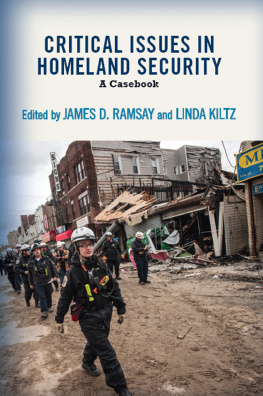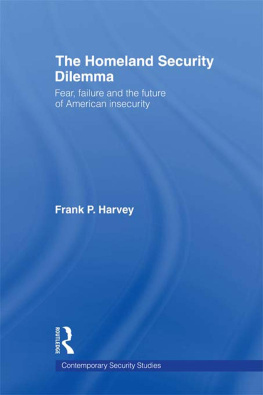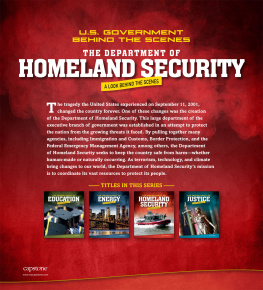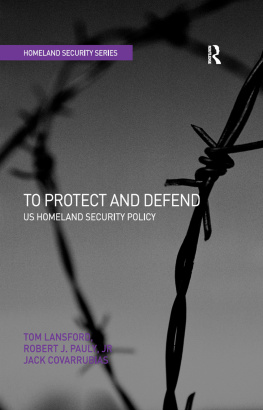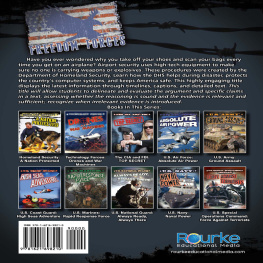CRITICAL ISSUES IN HOMELAND SECURITY
CRITICAL ISSUES IN HOMELAND SECURITY
A Casebook
Edited by
James D. Ramsay
EMBRY-RIDDLE AERONAUTICAL UNIVERSITY
Linda Kiltz
WALDEN UNIVERSITY
First published 2014 by Westview Press
Published 2018 by Routledge
711 Third Avenue, New York, NY 10017, USA
2 Park Square, Milton Park, Abingdon, Oxon OX14 4RN
Routledge is an imprint of the Taylor & Francis Group, an informa business
Copyright 2014 by Taylor & Francis
All rights reserved. No part of this book may be reprinted or reproduced or utilised in any form or by any electronic, mechanical, or other means, now known or hereafter invented, including photocopying and recording, or in any information storage or retrieval system, without permission in writing from the publishers.
Notice:
Product or corporate names may be trademarks or registered trademarks, and are used only for identification and explanation without intent to infringe.
Every effort has been made to secure required permissions for all text, images, maps, and other art reprinted in this volume.
Designed by Linda Mark
Library of Congress Cataloging-in-Publication Data
Ramsay, James D.
Critical issues in homeland security : a casebook / James D. Ramsay, Linda A. Kiltz.
pages cm.
Includes bibliographical references and index.
ISBN 978-0-8133-4827-8 (pbk.) ISBN 978-0-8133-4828-5 (ebook)
1. United States. Department of Homeland SecurityCase studies. 2. National securityUnited StatesCase studies. 3. United StatesPolitics and governmentCase studies. 4. United StatesForeign relationsCase studies. I. Kiltz, Linda Ann. II. Title.
HV6432.4R35 2014
363.34560973dc23
2013029846
ISBN 13: 978-0-8133-4827-8 (pbk)
To my eternally patient and understanding wife, Trish, and my terrific kids, Margo and David, who regularly remind me of the most important things in life.
Jim
To my wonderful husband, Don, for his love and support in everything that I do.
Linda
Contents
Tobias T. Gibson
Richard T. Sylves
Linda Kiltz
Linda Kiltz
James D. Ramsay and John Lanicci
John M. Lanicci and James D. Ramsay
Steve Young
Steve Young
Linda Kiltz
Gary C. Kessler
Frances L. Edwards
Frances L. Edwards
David A. McEntire
Joshua Kelly and David A. McEntire
Thank you for taking a moment to read through the table of contents and to ponder how this text might benefit your program. The purpose of this foreword is to illustrate the logic of this books organization and to suggest how it might be used by your students across the core curriculum. The homeland security enterprise, as it has come to be known, is a large interconnected network of public and private organizations, academic disciplines, and a wide variety of practitioners. Practical applications and examples of real-life homeland security challenges not only add value to the classroom experience but provide exciting examples of classroom principles in practice and enable students to imagine how they might have thought about or handled a real situation differently had they been involved or in charge.
Our aim in putting this book together was to present case studies that facilitate such enhanced learning and show instructors how to engage their audiences. There were two fundamental approaches to how such a text might be organized. The more traditional style would have been to present case studies completely dedicated to a singular focus or application disciplineall intelligence cases, for example. We chose the second approach instead: the book is organized into seven application or focus areas (i.e., chapters), and the challenges facing each of those areas is highlighted with two robust case studies. This approach yields not only fourteen outstanding case studies representing the challenges that face the homeland security enterprise and its practitioners but also offers to academic programs an efficient and economically viable alternative to the one book, one topic structure.
Youll notice that the fourteen case studies are organized into seven chapters and two parts. Our thinking in organizing the text this way is twofold; first, from an economic perspective, this organization allows academic programs to acquire one text that can be used in seven or more classes. With the chapter titles Law and Policy, Terrorism, Environmental Security, Intelligence, Critical Infrastructure Protection, Transportation Security, and Emergency Management, it is easy to imagine how this book might align itself with several core courses in most homeland security programs. In addition, each case study includes thoughtful and provocative questions that the instructor can use to motivate and structure class discussion. The instructor guide provides not only sketch answers to each of these questions but many helpful tips and resources to help you use the case study approach in your classes.
We hope you find this text to be an innovative, creative, and fun teaching tool that helps your students see the richness and complexity of the many wicked problems they will encounter as homeland security professionals.
Jim Ramsay and Linda Kiltz
APT | advanced persistent threat |
AQAP | Al-Qaeda in the Arabian Peninsula |
ATF | Bureau of Alcohol, Tobacco, and Firearms |
AUMF | Authorization to Use Military Force |
CDC | Centers for Disease Control and Prevention |
CDEMA | Caribbean Disaster Emergency Management Agency |
CIA | Central Intelligence Agency |
CIKR | critical infrastructure and key resources |
CIP | critical infrastructure protection |
DHS | Department of Homeland Security |
DoD | Department of Defense |
DOT | Department of Transportation |
DPC | Directorate for Civil Protection (Haiti) |
ELF | Earth Liberation Front |
ERD | Emergency Response Division |
FBI | Federal Bureau of Investigation |
FDNY | Fire Department of New York |
FEMA | Federal Emergency Management Agency |
FISA | Foreign Intelligence Surveillance Act |
GWOT | Global War on Terrorism |
HPH | health care and public health |
HSPD | Homeland Security Presidential Directive |
HTUA | high-threat urban area |
IC | incident commander |
ICE | |

